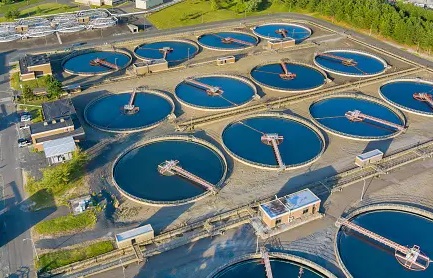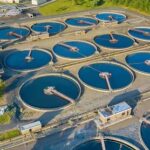A sewage treatment plant, also known as a wastewater treatment plant or a sewage treatment works, is a facility that processes wastewater or sewage to remove impurities and contaminants before releasing the treated water back into the environment or disposing of it safely. The primary goal of sewage treatment is to protect public health and the environment by treating sewage to remove harmful substances and pathogens.
STP Process typically involves several stages:
Inflow and Screening:
- Wastewater enters the treatment plant through sewer pipes or pumping stations.
- Large objects like sticks, leaves, and trash are removed at the inlet using screens or bar racks.
Primary Treatment:
- In this stage, large solid particles and some organic matter settle out of the wastewater through sedimentation.
- The wastewater flows into large settling tanks or clarifiers, allowing heavier solids to sink to the bottom and form sludge.
- The clarified water on top is then separated from the settled solids.
Secondary Treatment (Biological Treatment):
- The effluent from primary treatment still contains dissolved and suspended organic matter, as well as microorganisms.
- In secondary treatment, microorganisms (usually bacteria) are used to break down the remaining organic matter in the wastewater.
- There are two main methods for secondary treatment: activated sludge process and trickling filter process.
- Activated Sludge Process: Wastewater is mixed with a “sludge” containing microorganisms in aeration tanks, where the microorganisms consume organic matter. The mixture is then settled, and the treated water is separated from the sludge.
- Trickling Filter Process: Wastewater is distributed over a bed of rocks or plastic media where microorganisms grow and break down organic matter. The treated water is collected and sent for further processing.
Tertiary Treatment (Optional):
- Tertiary treatment is an additional step used to further improve water quality when necessary.
- It may involve advanced processes such as filtration, chemical precipitation, or the use of UV or ozone to disinfect the water and remove any remaining contaminants.
Sludge Treatment:
- The sludge generated in primary and secondary treatment processes needs to be treated and disposed of properly.
- Sludge can be thickened, dewatered, and treated to reduce its volume and remove pathogens.
- Common methods for sludge treatment include anaerobic digestion, aerobic digestion, and mechanical dewatering.
- Treated sludge can be used as fertilizer, incinerated, or disposed of in a landfill, depending on its characteristics and local regulations.
Discharge or Reuse:
- The final treated wastewater, now largely free of contaminants and pathogens, can be discharged into a receiving water body (e.g., river or ocean) if it meets regulatory standards.
- In some cases, treated wastewater can be reused for purposes like irrigation, industrial processes, or groundwater recharge, depending on the quality of the treated water.
Advantages of sewage treatment plants:
Environmental Protection:
Sewage treatment plants remove contaminants, pathogens, and pollutants from wastewater before it is discharged into the environment.
This helps protect natural water bodies, such as rivers, lakes, and oceans, from pollution and eutrophication, which can harm aquatic ecosystems.
Public Health Improvement:
Proper sewage treatment reduces the risk of waterborne diseases by eliminating harmful bacteria, viruses, and parasites from wastewater.
Treated water is safer for recreational activities, drinking water sources, and agricultural use.
Water Quality Enhancement:
Sewage treatment plants improve the quality of water in receiving bodies by reducing the levels of nutrients (e.g., nitrogen and phosphorus) that can lead to algal blooms and oxygen depletion.
Cleaner water supports biodiversity and maintains a healthier ecosystem.
Resource Recovery:
Some sewage treatment plants incorporate processes that allow for the recovery of valuable resources. For example, anaerobic digestion can produce biogas (methane) for energy generation, and the treated sludge can be used as fertilizer.
Reduced Odor and Aesthetic Improvement:
Sewage treatment helps eliminate unpleasant odors and unsightly conditions associated with untreated wastewater and sewage.
This can enhance the quality of life in the surrounding area and contribute to better community aesthetics.
Compliance with Regulations:
Sewage treatment plants ensure that wastewater discharges comply with local, regional, and national environmental regulations and standards.
Sustainable Water Management:
In regions facing water scarcity, treated wastewater can be used for non-potable purposes like irrigation, industrial processes, and cooling water for power plants, reducing the demand on freshwater sources.
Economic Benefits:
Properly treated wastewater can be safely reused in industrial processes, reducing water supply costs for businesses.
The recovery of resources from wastewater can also generate revenue or reduce disposal costs.
Reduced Flooding Risk:
Sewage treatment helps manage the flow of stormwater and wastewater, reducing the risk of flooding in urban areas during heavy rainfall events.
Improved Community Health:
Cleaner environments and better water quality contribute to overall community health and well-being.
Reduced exposure to waterborne pathogens and contaminants helps prevent water-related illnesses.
Long-Term Sustainability:
Sewage treatment contributes to the long-term sustainability of water resources by reducing the strain on freshwater supplies and protecting natural ecosystems.
Conclusion
STP Plants are essential for maintaining public health and protecting the environment by ensuring that wastewater is safely treated and released back into the ecosystem. The specific design and processes used in a sewage treatment plant may vary depending on its size, location, and the quality of the incoming wastewater.

